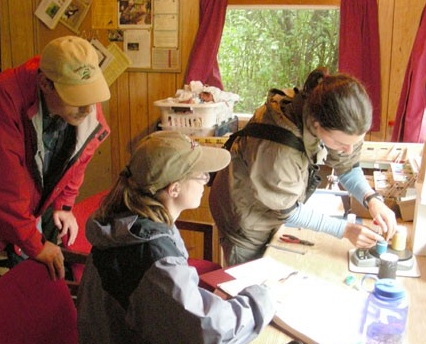Week 1: March 28 – April 3, 2007
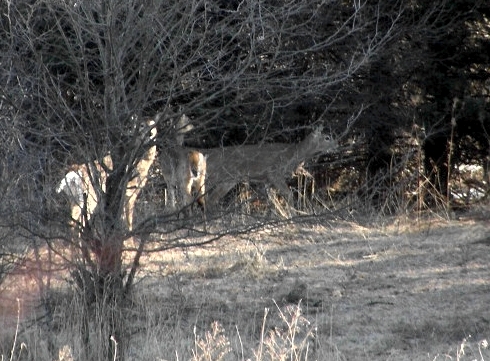
While there were signs of deer activity at MBO throughout the winter, these three are the first actually seen in a good while. Actually, two were seen earlier that morning in the field east of MBO, but they weren’t as photogenic. These three were quietly picking their way along the cedar row when they first noticed Marie-Anne rounding the corner at F while on census. Needless to say, they didn’t stick around much longer, opting instead to bound along the old census path that cuts through the conifer grove and into the field. (Photo by Marie-Anne Hudson)
| THIS WEEK | THIS SPRING | 2006 TOTAL | SITE TOTAL | |
| # birds (and species) banded | — | — | 41 (8) | 9359 (96) |
| # birds (and species) repeat | — | — | 12 (3) | 1561 (52) |
| # birds (and species) return | — | — | 4 (2) | 204 (26) |
| # species observed | 36 | 36 | 43 | 180 |
| # net hours | — | — | 37 | 14059.8 |
| # birds banded / 100 net hours | — | — | 110.8 | 66.5 |
Bander-in-charge: Marie-Anne Hudson
Assistants: Jean Beaudrault, Shawn Craik, Jean Demers, Barbara Frei, Gay Gruner, Barbara MacDuff, Betsy McFarlane, Clémence Soulard
Notes: With the end of the winter season, comes the beginning of the Spring Migration Monitoring Program (SMMP) at MBO! Our spring season is defined as the 10-week span from March 28 through June 5, with banding occurring daily from April 18 to June 2. A few bouts of non-standard banding will likely occur before then, however, as we set the nets up in anticipation of our “real” banding start.
Our first week of SMMP censuses was quite lovely, as temperatures were relatively warm and the sun shone brightly. We haven’t yet run our seasonal spring clean-up, opting instead to wait a few days until these few rainy days clear up a little. There is much work to do done: hauling some leftover research equipment out of the woods before the vines overtake it (again), cleaning out the cabin and putting up our newly-donated corkboard (thanks to Elise and Rodger Titman), re-gravelling some of the trails for safe passage, and trimming the census path and net lanes are just a few items on our agenda.
The birds have already been streaming in over the past week, with new species added to the yearly checklist almost daily. Tuesday was the best day, with 28 species recorded on census, including 3 new arrivals for 2007 – Green-winged Teal, Purple Finch, and Golden-crowned Kinglet. It’s been a mix of “spring” and “winter” birds, with Red-winged Blackbirds and Killdeer commingling with American Tree Sparrow and Slate-colored Juncos. At least three Eastern Phoebes have already been on territory for a few days, and Song Sparrow and Red-winged Blackbird numbers have tripled from earlier in the week. Waterfowl have dominated this week, with thousands of Canada Geese milling about in the field to the east of MBO. A very special note: our neck-banded Canada Goose, H1F1, is back at Stoneycroft for a second year! We hope he/she will stick around to breed. In addition to the geese, we’ve seen Green-winged Teal, Wood Duck, Northern Pintail, Common and Hooded Merganser, American Black Duck and oodles of Mallards. The total of 36 species observed this week is very similar to last spring’s first week tally of 37, although some of the species on the list have changed. Of these week’s observations, 12 species were new additions to our 2007 list… and there are many more to come!
| This week’s Top Ten | |
| # individuals banded | mean # individuals observed daily |
| – | Canada Goose (1098.9) |
| – | Red-winged Blackbird (47.1) |
| – | American Crow (17.3) |
| – | Ring-billed Gull (16.9) |
| – | Mallard and American Robin (13.3) |
| – | Blue Jay (10.0) |
| – | Song Sparrow (7.0) |
| – | Black-capped Chickadee (6.4) |
| – | European Starling (5.0) |
| – | Slate-colored Junco (4.4) |
Week 2: April 4-10, 2007
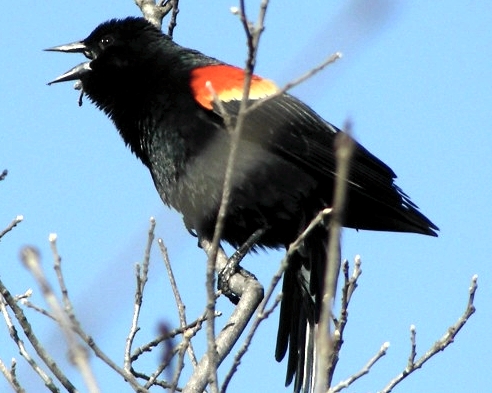
Though this vocal male didn’t perch in the greatest position for band-spotting, one male Red-winged Blackbird has been spotted sporting a band. It’s only a matter of time before we get one in the nets! (Photo by Marie-Anne Hudson)
| THIS WEEK | THIS SPRING | 2006 TOTAL | SITE TOTAL | |
| # birds (and species) banded | — | — | 41 (8) | 9359 (96) |
| # birds (and species) repeat | — | — | 12 (3) | 1561 (52) |
| # birds (and species) return | — | — | 4 (2) | 204 (26) |
| # species observed | 38 | 45 | 50 | 181 |
| # net hours | — | — | 37 | 14059.8 |
| # birds banded / 100 net hours | — | — | 110.8 | 66.5 |
Bander-in-charge: Marie-Anne Hudson
Assistants: Chris Alsop, Jean Beaudrault, Martin Bowman, Sophie Cauchon, Shawn Craik, Jean Demers, Christina Donehower, Barbara Frei, Gregor Gilbert, Gay Gruner, Barbara MacDuff, Sarah Marteinson, Betsy McFarlane, Mark O’Connor, André Pelletier, Clémence Soulard, Rodger Titman
Notes: This week was all about census and our annual spring clean-up. A small group of dedicated volunteers worked their tails off for two days to get the site ready for spring banding. New boardwalks were built, a new release platform was put together, the cabin was cleaned out, the nest boxes were cleaned out, the nets were set up, and almost 15 tons of gravel were spread out in especially muddy areas around the site. We would like to extend a large thank you to our assistants for working to tirelessly and enthusiastically to ensure that this work was completed well before banding was scheduled to begin.
The highlight of the week in terms of birds was the discovery of a pair of Ring-necked Ducks on Stoneycroft Pond – our first new addition to the MBO checklist this year, and the 181st species on it overall. Stoneycroft Pond actually provides some suitable breeding habitat for Ring-necked Duck, including shallow water and emergent vegetation. The pair was seen again on a couple of other censuses later in the week, so at least in the short term it seems they are hanging around.
Despite some pretty terrible weather early in the week, this week’s censuses netted us 8 other new species for this season, and 6 new species for 2007: Turkey Vulture, Brown Creeper, American Wigeon, Great Blue Heron, Red-tailed Hawk, Yellow-bellied Sapsucker, Yellow-shafted Flicker, and Cooper’s Hawk.
This week’s top ten is quite similar to last week’s, with a slight shuffle after the top five. The number of Canada Geese has dropped substantially, however, most being spotted going to and from the fields east of MBO.
| This week’s Top Ten | |
| # individuals banded | mean # individuals observed daily |
| – | Canada Goose (178.0) (1) |
| – | Red-winged Blackbird (48.3) (2) |
| – | American Crow (21.6) (3) |
| – | Ring-billed Gull (13.0) (4) |
| – | American Robin (10.3) (5) |
| – | Song Sparrow (9.3) (7) |
| – | Black-capped Chickadee (9.3) (8) |
| – | Wood Duck (8.4) (-) |
| – | Mallard (8.0) (5) |
| – | Blue Jay (7.4) (6) |
Week 3: April 11-17, 2007
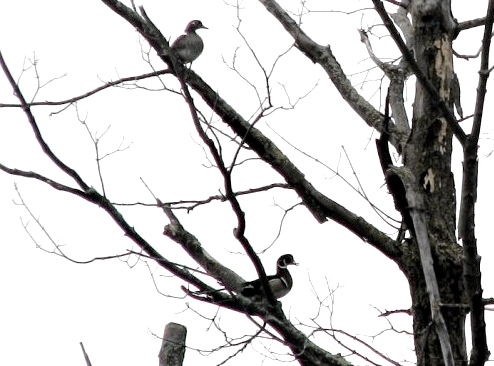
A sight to wake up for – early Saturday morning a pair of Wood Ducks were living up to their names a they perched in a large tree overlooking Stoneycroft Pond. We hope that one of
the 2 or 3 pairs sighted almost daily might make use of one of the 4 nest boxes on site. (Photo by Barbara Frei)-
| THIS WEEK | THIS SPRING | 2006 TOTAL | SITE TOTAL | |
| # birds (and species) banded | — | — | 41 (8) | 9359 (96) |
| # birds (and species) repeat | — | — | 12 (3) | 1561 (52) |
| # birds (and species) return | — | — | 4 (2) | 204 (26) |
| # species observed | 36 | 49 | 53 | 181 |
| # net hours | — | — | 37 | 14059.8 |
| # birds banded / 100 net hours | — | — | 110.8 | 66.5 |
Bander-in-charge: Barbara Frei
Assistants: Jean Beaudreault, Martin Bowman, Shawn Craik, Jean Demers, Gregor Gilbert, Gay Gruner, Barbara MacDuff, Betsy McFarlane, Clémence Soulard,
Notes: The 3rd week of the spring was a turbulent one indeed, and most would agree that a good portion of it did not feel spring like in the least! This was the final non-banding week of MBO’s spring 2007 season, and thanks to some dedicated volunteers everything was ready to go, with the census route clipped, nets readied and pole strings tightened.
Despite the well-below normal temperatures and snowfall on Sunday night, further signs of spring slowly emerged beneath the frosty exterior. Wood Ducks were seen 6 out of the 7 days, and other waterfowl such as Mallards, American Black Ducks, Green-winged Teal, Ring-necked Ducks and Hooded Mergansers were seen visiting our ponds or flying overhead
Four new species were seen for spring 2007 this week. Some large flocks of Snow Geese joined the Canada Geese on their continued migration northwards, and if you were patient enough to scan the flocks you were usually rewarded with a sight of the darker ‘blue-morph’ of the species. The rattling call of a male Belted Kingfisher greeted censusers early Saturday morning as it perched atop the large cottonwood trees bordering the rear ponds. Cold and blustery Sunday and Monday morning censuses brought a sole White-throated Sparrow and Northern Harrier respectively, a small but pleasant reward for stiff fingers and frosty binoculars.
| This week’s Top Ten [last week’s rank in brackets] | |
| # individuals banded | mean # individuals observed daily |
| – | Canada Goose (198) (1) |
| – | Red-winged Blackbird (31) (2) |
| – | Snow Goose (28) (-) |
| – | American Crow (20) (3) |
| – | American Robin (13) (5) |
| – | Black-capped Chickadee (9) (6) |
| – | Blue Jay (9) (10) |
| – | Mallard (8) (8) |
| – | Ring-billed Gull (8) (4) |
| – | Song Sparrow (6) (6) |
With the cold weather and northern winds stalling the migrants south of us, the top ten this week has not changed a great deal. The migrating Canada Geese and ubiquitous Red-winged Blackbirds remain at the top of the species observed. The flocking Snow Geese, often recognized by their higher pitched call and far more disorganized flight than their larger and darker cousins, rapidly jumped to 3rd place. Wood Duck and European Starling dropped from the top ten this week as Black-capped Chickadees and Blue Jays slowly climbed the ranks.
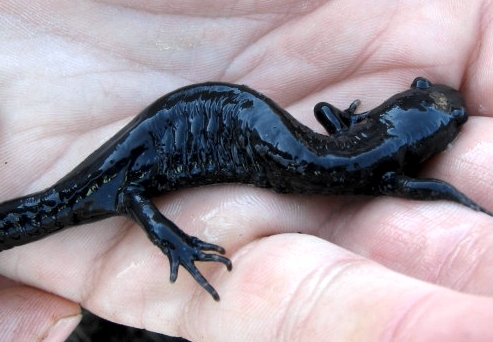
With the sighting of several duck species this week as well as the appearance of the season’s first Belted Kingfisher, the naturalist curiosity kicked in for some of us – leading to a closer look at what exactly is beneath the water of our ponds and small wetlands. The answer thus far is several dozen leeches and water beetles, as well as a healthy salamander population. (Photo by Barbara Frei)
Week 4: April 18-24, 2007
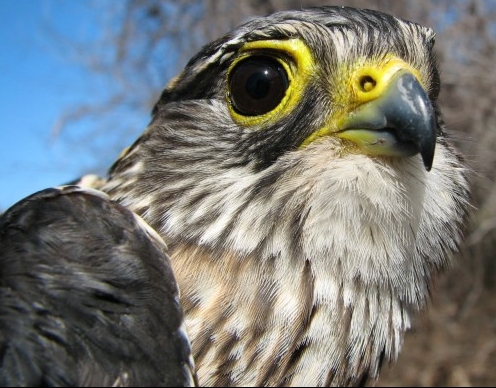
It was difficult to decide which of the birds banded this week deserved the top honour of photo of the week, but ultimately we settled on our first ever Merlin and his fierce eyes …
the runner-up is featured within the report below.
(Photo by Barbara Frei)-
| THIS WEEK | THIS SPRING | 2006 TOTAL | SITE TOTAL | |
| # birds (and species) banded | 57 (13) | 57 (13) | 98 (18) | 9416 (97) |
| # birds (and species) repeat | 13 (2) | 13 (2) | 25 (5) | 1574 (52) |
| # birds (and species) return | 12 (4) | 12 (4) | 16 (6) | 216 (26) |
| # species observed | 66 | 70 | 70 | 183 |
| # net hours | 413.5 | 413.5 | 450.5 | 14398.3 |
| # birds banded / 100 net hours | 13.8 | 13.8 | 21.1 | 65.3 |
Banders-in-charge: Barbara Frei, Lance Laviolette
Assistants: Jean Beaudreault, Martin Bowman, Gilles Burelle, Sophie Cauchon, Shawn Craik, Jean Demers, Gregor Gilbert, Gay Gruner, Amy Henderson, Helen Laroux, Andrée Dubois-Laviolette, Barbara MacDuff, Don MacDuff, Betsy McFarlane, André Pelletier, Andrew Plimer, Clémence Soulard
Notes: Week 4 was the first week of banding for spring 2007! Although the nets were fairly quiet – as expected for early spring – it was an exciting week nonetheless. Banding took place on 6 out of the 7 days – with our guest BIC Lance Laviolette banding on one of them.
Week 4 was much changed from our previous weeks in that it actually felt as if spring (sometimes even summer!) had finally arrived; in fact the temperatures soared from the below freezing we experienced the weeks before to over 20°C. The springtime was felt by all, as bird, amphibian, reptile, and mammal activity increased. In our ponds we observed Muskrats and Painted Turtles, and we were greeted every morning with a chorus (sometimes almost deafening!) of Spring Peepers, Wood Frogs and Leopard Frogs.
We had several highlights this week, with 22 new species observed and 13 species banded for the first time this year. The excellent species diversity this week brought the season total to 71 species observed – exactly where it was at this point in 2006! The banding total remains much lower, but that is to be expected as we decided that we decided not to band during the first three weeks this year as the mornings are often still too cold during that period, and it will be easier to maintain a consistent level of effort from year to year if we start somewhat later. The decision was made easier by the fact that 2006 proved to us that few birds are on the move during those first few cool weeks – we banded an average of fewer than 30 per week, which is far below MBO’s usual standards
Thursday morning the skies turned white as several giant waves of Snow Geese migrated passed. Our heads craned back, we attempted to count the numbers and reached a verdict of at least 4500 geese passing us in mere minutes on their sojourn northwards. Later that morning our heads turned skywards again and our faces were wreathed with smiles as we happily greeted the first of the Tree Swallows to revisit our fields. While walking down the D-nets and admiring the acrobatics of the swallows above us, we were suddenly startled as a dark blur buzzed right before our faces and a second later heard a resounding crash near the A nets. Five minutes later we had in our hands MBO’s first Merlin, a gorgeous slate blue after-second-year male.
Sunday operations were run by our guest BIC – Lance Laviolette – and was a unique day for him, as he banded his first Pileated Woodpecker, only the 3rd to be banded at MBO (the last one coming just slightly earlier in spring last year). An impressively large bird (with an especially large bill!) is an awe-striking sight from a nearby tree and even more so in the hand – but under Lance’s expert hand the woodpecker was soon banded and sent back on his way. Also on Sunday we had the season’s first sightings of a soaring Rough-legged Hawk and a Wilson’s Snipe.
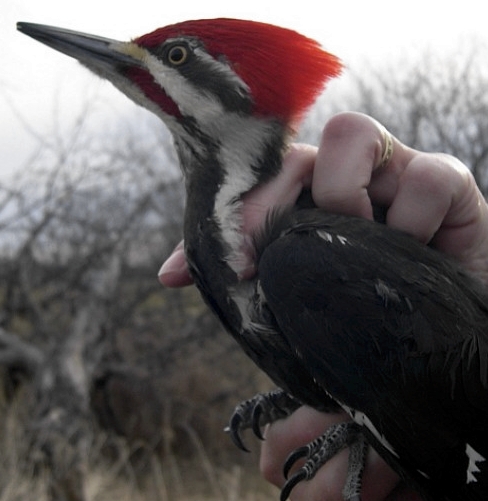
Our other star catch of the week was this Pileated Woodpecker, only the third ever
banded at MBO, and the first male – as recognized by his red moustache
(Photo by Andrée Dubois-Laviolette)
A rather summery Monday brought a total of 8 new species for spring 2007: Blue-winged Teal, Osprey, Broad-winged Hawk, Winter Wren, Ruby-crowned Kinglet, Myrtle Warbler, Savannah Sparrow and Rusty Blackbird. The chuckling call of the Ruby-crowned Kinglets were soon heard from every corner and there was no surprise that they as well as their smaller cousins, the Golden-crowned Kinglet, found their way into the nets.
Our week ended with no less excitement. Tree Swallow numbers grew to 16 individuals, and favourite nest boxes were marked by pairs of swallows perched on the roofs. Both Tree Swallows and Swamp Sparrows were newly banded species on Tuesday. The trill of the Chipping Sparrow and musical song of the House Finch added these two species to our spring list. Tuesday was a very memorable day for MBO, as we added two new species to our overall list, thanks to the keen eyes and ears of our volunteers, especially Betsy McFarlane and Andrew Plimer. Along with the Savannah Sparrows calling from the grassy field next to the station, a pair of Vesper Sparrows was spotted flitting amid the tangled hedge and grasses. Late in the morning, the unmistakable silhouette of a Sandhill Crane soared in the distance causing great excitement as it circled the area, apparently searching for a place to land. This increased our total of bird species seen at MBO to 183 species.
| This week’s Top Ten [last week’s rank in brackets] | |
| # individuals banded | mean # individuals observed daily |
| Red-winged Blackbird (12) {-} | Snow Goose (791) {3} |
| Song Sparrow (9) {-} | Canada Goose (322) {1} |
| American Robin (8) {-} | Red-winged Blackbird (73) {2} |
| Ruby-crowned Kinglet (6) {-} | American Crow (33) {4} |
| American Goldfinch (4) {-} | Ring-billed Gull (32) {9} |
| Black-capped Chickadee (3) {-} | American Robin (26) {5} |
| Downy Woodpecker (3) {-} | Song Sparrow (24) {10} |
| Eastern Phoebe (3) {-} | American Goldfinch (15) {-} |
| Golden-crowned Kinglet (2) {-} | Mallard (14) {8} |
| American Tree Sparrow (2) {-} Swamp Sparrow (2) {-} | Black-capped Chickadee (14) {6} |
The top ten species banded are not very surprising – Red-winged Blackbirds, Song Sparrows, American Robins and Black-capped Chickadees are all actively establishing their territories in preparation for the summer breeding period. The numbers of American Tree Sparrows are dropping as they migrate further north to their breeding grounds. The Ruby-crowned Kinglets will most likely be in our top ten list for some weeks to come as we expect their numbers will increase with time. As our overall number of birds banded is still low – we have are less numerous species, such as the Downy Woodpecker and the Eastern Phoebe gracing our list. We also had a Phoebe that was banded last year return to our site and revisit our nets – it is always nice to see individuals successfully return to MBO after their southern journey. In total we had 13 individuals returning of 6 different species.
Snow Geese top our list of species observed this week as a consequence of the large migration on Thursday. Other than this leap to the top position and a slight reshuffling of positions, no major changes have taken place in the top 10 observed species for the 4th week of spring. But with the warmer weather and hopefully some southerly winds – this will change in the coming weeks as the migrants flood our area on their way northwards.
It is interesting to note that at this time last year, Northern Pintail, Brown-headed Cowbird, and Slate-coloured Junco were among the top 10 species observed, with a daily average of 12 to 24 individuals observed; however, the Snow Geese that have been so abundant lately were not around at all at this time last spring, and American Goldfinch and Black-capped Chickadee are also slightly more numerous currently than at this time in 2006.
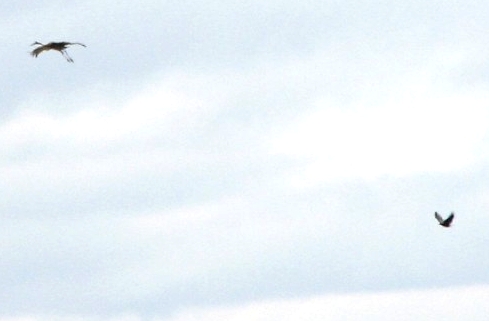
American Crows are infamous for their love of chasing raptors – and as this photo shows, other large birds, such as this Sandhill Crane which dwarfs the trailing crow. Now it seems our next challenge is to see another kind of crane … everyone keep their binoculars ready! (Photo by Barbara Frei)
Week 5: April 25 – May 1, 2007
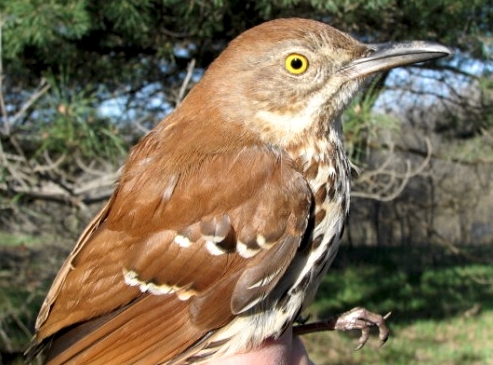
There is just nothing like a mimic’s song first thing in the morning. We were very happy to see this Brown Thrasher – a species facing population declines – and he/she seemed happy to see us for he/she kept reappearing in our nets!! (Photo by Barbara Frei)
| THIS WEEK | THIS SPRING | 2006 TOTAL | SITE TOTAL | |
| # birds (and species) banded | 14 (4) | 71 (14) | 112 (19) | 9430 (97) |
| # birds (and species) repeat | 3 (3) | 16 (4) | 28 (7) | 1577 (52) |
| # birds (and species) return | 2 (2) | 14 (5) | 18 (7) | 218 (27) |
| # species observed | 58 | 78 | 78 | 183 |
| # net hours | 75 | 488.5 | 525.5 | 14473.3 |
| # birds banded / 100 net hours | 18.7 | 14.5 | 20.7 | 65.1 |
Bander-in-charge: Barbara Frei
Assistants: Jean Beaudreault, Gilles Burelle, Shawn Craik, Jean Demers, Gregor Gilbert, Emily Gray, Christine Gray, Gay Gruner, Helen Laroux, Barbara MacDuff, Don MacDuff, Betsy McFarlane, Clémence Soulard,
Notes: There was no denying spring was in the air in the 5th week of the spring migration. Unfortunately, a combination of late April showers and conflicts in the BIC schedule meant that banding took place solely on one day of week 5. Yet, even with the diminished coverage of the week and the continued stalling of migration due to the cold northern winds dominating the weather fronts, we are at 79 species observed on site, only 1 behind last year at this time. A big round of applause for our dedicated censusers and volunteers for braving the weather and early mornings to search out those elusive warblers and other spring migrants slowly trickling in!
We have a total of 8 new species observed this week. Common Loons and Double-crested Cormorants with their streamlined and arrow-shaped bodies were lone silhouettes breaking through the rosy dawns on several mornings this week. A Western Palm Warbler flitted among budding branches of the Manitoba Maples lining the driveway, in company of the increasing (from last week) Ruby-crowned Kinglets whose chuckling laughter resonated throughout the site. On a rainy and cold Friday morning, a silent Hermit Thrush darted into the wet tangles of shrubs and vines down the back path, flashing his rusty rump to brighten the censuser’s day.
A warm and bright Tuesday morning brought several more birds. The growing swarm of Tree Swallows hid amongst them a smaller and duller Bank Swallow as it joined the revelry of dazzling aerobatics against the backdrop of a matchless blue sky. A closer look above the far ‘golfball-shaped’ weather station showed a turbulent mass of Cliff Swallows entering and exiting their nests. Another shy warbler was spotted hiding amongst the spring green leaves – a male Nashville Warbler. Lastly, a highlight of the day was the multiple sightings of Brown Thrashers – 3 in all – singing their wonderfully erratic song or skulking in the bushes. One individual was banded and proceeded to get caught 2 more times, always in different nets! We didn’t mind the closer look at all.
Since all the banding this week occurred on a single day, the top ten banded this week displays no particular trend – other than the fact that the Red-winged Blackbirds remained the most plentiful. For the top ten observed, Canada Geese and Red-winged Blackbirds are again at the top – similar to last week and this week last year (some things don’t change that easily it seems!). Tree Swallows are far more plentiful this year than last – with almost every nest box being occupied by a pair. The familiar Song Sparrows are often singing within their territories or paired together as they search the grassy fields for hummocks that would make a good shelter to tuck their nest beneath (so watch out underfoot!). American Goldfinches and Ruby-crowned Kinglets are still plentiful, while American Tree Sparrows, Slate-colored Juncos, Golden-crowned Kinglets and American Robins have disappeared or decreased in number as they continue to migrate.
Although the winds continued from the north – stalling migration – there was no denying of spring. Buds of the apple and hawthorn trees have broken with a whispered promise of fresh green leaves. In the forest understory there is a carpet of the speckled Trout Lily leaves, Wood Violets and Trilliums. The grass grows so quickly that another centimeter grows every time our backs turn for a moment, and the pond is filled with Wood Frogs, Leopard Frogs, Spring Peepers and Painted Turtles. Every moment is more exciting then the last!
| This week’s Top Ten [last week’s rank in brackets] | |
| # individuals banded | mean # individuals observed daily |
| Red-winged Blackbird (11) {1} | Canada Goose (109) {2} |
| Tree Swallow {-} | Red-winged Blackbird (65) {3} |
| Brown Thrasher {-} | American Crow (25) {4} |
| Brown Thrasher {-} | Tree Swallow (16) {-} |
| Song Sparrow (15) {6} | |
| American Goldfinch (13) {7} | |
| Ruby-crowned Kinglet (12) {-} | |
| American Robin (11) {6} | |
| Black-capped Chickadee (8) {10} | |
| White-throated Sparrow (8) {-} |
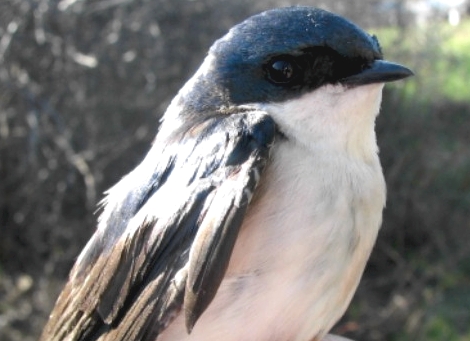
Tree Swallows are numerous at MBO this spring – a delightful sight for all our visitors! They are certainly a species built for flight, with their elegant long wings and small delicate feet. As effortless as their aerial dances are, they are clumsy and staggering when they alight on the ground to pick up grasses and twigs for their nests. (Photo by Barbara Frei)
Week 6: May 2-8, 2006
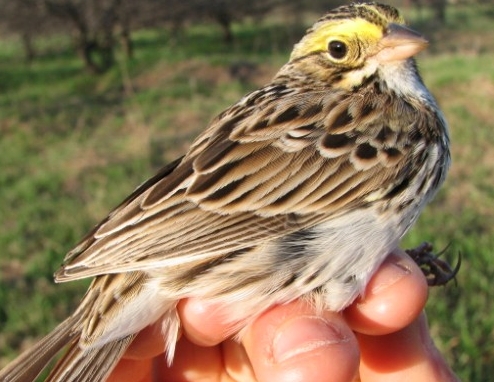
The delicate coloration of the Savannah Sparrow is well suited for this grassland species, whose soft and musical trill can be heard along the field edge every morning this spring at MBO. Perhaps this enchanting sparrow can make some birders rethink the impression that all sparrows can be lumped together as ‘little-brown-jobs’. (Photo by Barbara Frei)
| THIS WEEK | THIS SPRING | 2006 TOTAL | SITE TOTAL | |
| # birds (and species) banded | 86 (13) | 157 (20) | 198 (25) | 9516 (97) |
| # birds (and species) repeat | 12 (4) | 28 (6) | 40 (9) | 1589 (52) |
| # birds (and species) return | 12 (5) | 26 (7) | 30 (9) | 230 (27) |
| # species observed | 79 | 97 | 97 | 184 |
| # net hours | 510 | 998.5 | 1035.5 | 14983.3 |
| # birds banded / 100 net hours | 16.9 | 15.7 | 18.8 | 63.5 |
Banders-in-charge: Barbara Frei, Marie-Anne Hudson, Lance Laviolette
Assistants: Jean Beaudreault, Sophie Cauchon, Natalia Castellanos, Jean Demers, Gregor Gilbert, Emily Gray, Gay Gruner, Amy Henderson, Helen Laroux, Meghan Laviolette, Andrée Dubois-Laviolette, Barbara MacDuff, Don MacDuff, Sarah Marteinson, Betsy McFarlane, Chris Murphy, Andre Pelletier, Clémence Soulard,
Notes: Spring just keeps on coming! Full coverage was enabled in the 6th week of our spring monitoring season with the help of our wonderful guest bander – Lance Laviolette and the return of MBO’s other leading lady bander, Marie-Anne. Despite a couple of chilly mornings, the sunshine and warmth continued and it was clear to everyone that yes, spring is now here to stay. And with this distinction the buds broke and leaves emerged, no more a delicate promise but a full and blatant beauty of rich dewy green. The frogs continue their chorus and fat tadpoles lazily circle the warm and muddy banks. And the birds… well, 20 new species for the year have arrived!
Early Thursday morning as the fog was lifting from the marsh, we emerged from the banding station to begin a net round, when a keen volunteer pointed out the elegant silhouette of an American Bittern slowly rising from the waters by which it had spent the night. Later that day two more species were added to the list of new spring species, as the meow of a Gray Catbird alluded to a ‘bird in the bush’ and the sweet whistle of a Eastern Meadowlark, the first sighting ever for MBO, reminded us that yes, it is the ‘spring of the year’, as the meadowlark sings..
Lance, our ‘warbler-man’, lived up to his name, for he banded the season’s first warbler on Saturday, a rather shabby second-year Northern Waterthrush. Our small marsh produced another spring newcomer, a rather insistent Virginia Rail which called loudly most of the morning – perhaps complaining about the rather chilly start to the day. In addition to the Northern Waterthrush, a Savannah Sparrow and Hairy Woodpecker were newly banded for the season.
Sunday was a lovely day for our tour for the members of COA – our welcome visitors for the day. With several additional eyes we had some excellent observations for the day. This included a reticent Yellow Palm Warbler skulking in the undergrowth and a soaring Northern Rough-winged Swallow among the turbulent cloud of Tree Swallows. The highlight of the day was the wonderfully liquid gurgle and bubble of a Bobolink – appearing from nowhere to sing atop a tree just outside the banding station to the delight and surprise of everyone on site. He flew towards the grassy field just adjacent to MBO – a field that has also brought several other grassland species to the area in recent weeks, including Savannah Sparrows, Vesper Sparrows and Eastern Meadowlarks. Let us hope that McGill University can acknowledge and properly manage this grassland habitat for the disappearing grassland species therein. For more information on Bobolinks and conservation management for the species, please see our grassland conservation page.
Finally on Tuesday there were some southerly winds, and over the course of the warm evening a flood of migrants arrived, including the long awaited warblers! Ten new species greeted the happy volunteers on a true spring morning and the newly green treetops of MBO were full of song: Blue-headed Vireo, Northern Parula, Black-throated Green Warblers, Blackburnian Warblers, Black and White Warblers, Ovenbirds, Common Yellowthroats, Eastern White-crowned Sparrows, Magnolia Warblers and Rose-breasted Grosbeaks … all of which were eagerly invited to come for a visit into the nets for a closer look.
Overall, bird migration is still behind this year compared to our numbers of last year, a fact that will hopefully change soon now that the gates of migrations have finally swung open. Due to the incomplete coverage and slower movement there are fewer species and individuals banded in the current spring season compared to week 6 of 2006. But this year we are only 2 species behind the 100 we had sighted at this last year – thanks to our dedicated and sharp-eyed volunteers!
| This week’s Top Ten [last week’s rank in brackets] | |
| # individuals banded | mean # individuals observed daily |
| Ruby-crowned Kinglet (31) [-] | Canada Goose (431) [1] |
| Red-winged Blackbird (27) [1] | Red-winged Blackbird (97) [2] |
| White-throated Sparrow (7) [-] | Snow Goose (57) [-] |
| American Goldfinch (6) [2] | American Crow (28) [4] |
| Common Grackle (5) [-] | Tree Swallow (27) [-] |
| Downy Woodpecker (2) [-] | Ring-billed Gull (24) [6] |
| Savannah Sparrow (2) [-] | Cliff Swallow (21) [-] |
| American Robin [-] Black-capped Chickadee [-] Tree Swallow [-] (1 each) |
Ruby-crowned Kinglet (18) [7] |
| Song Sparrow (17) [5] | |
| American Goldfinch (15) [7] |
Our top ten species observed have not altered much from last week or the previous years with 2 exceptions. White-throated Sparrows remain in very small numbers this year and are not even close to the top ten species observed, though they were regularly in that list last spring. The swallow numbers have increased on the other hand, Tree Swallows being close to double their number in 2006 and Cliff Swallows also appearing in the top ten this week thanks to birds flying over from the colony near the Arboretum’s main gate.
Ruby-crowned Kinglets remain at the top of the banded list – though this may be the last week in this position until the fall migration for their numbers were decreasing at the end of the week. The ubiquitous Red-winged Blackbirds remain high on the list, with a fair portion of those banded now being females.
Although excited for what we have seen we must also mention what has moved on northwards. Golden-crowned Kinglets, American Tree Sparrows, and Slate-colored Juncos have quietly vanished from our records as they push further towards the Boreal forest to the north. American Robin numbers have steadily decreased and one species ‘missing in action’ is the Fox Sparrow – yet unseen at MBO this spring, and not likely to make this season’s list as it is typically one of the earlier migrants.
So the questions on all our minds is, what will the gentle south winds blow in for us next week?

An uncommon and delightful visitor to MBO, this Bobolink was a welcome surprise on Sunday morning, charming everyone with its delightful bubbly song. This species has been declining over much of its Canadian and American breeding range, so it is an all the more welcome sight for us. (Photo by Barbara Frei)
Week 7: May 9-15, 2007
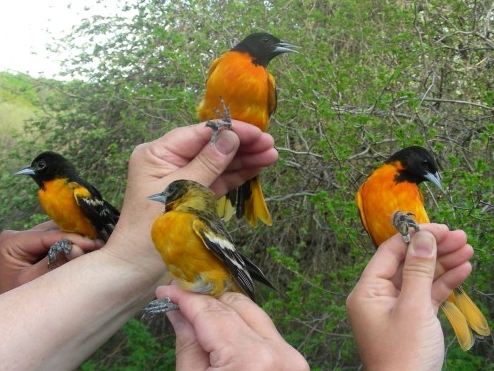
We believe that this is a first for MBO: four Baltimore Orioles all staying perfectly still
while a photo is being taken, though regrettably not mugging for the camera. These four were plucked out of the nets during the same round, adding much colour and attitude to the morning. (Photo by Marie-Anne Hudson)
| THIS WEEK | THIS SPRING | 2006 TOTAL | SITE TOTAL | |
| # birds (and species) banded | 202 (34) | 359 (40) | 400 (45) | 9718 (98) |
| # birds (and species) repeat | 16 (9) | 44 (10) | 56 (13) | 1605 (52) |
| # birds (and species) return | 18 (9) | 44 (13) | 48 (15) | 248 (28) |
| # species observed | 91 | 116 | 116 | 185 |
| # net hours | 454.5 | 1453 | 1490 | 15512.8 |
| # birds banded / 100 net hours | 44.2 | 24.5 | 26.6 | 62.6 |
Banders-in-charge: Barbara Frei, Marie-Anne Hudson
Assistants: Chris Alsop, Sylvie Bazinet, Jean Beaudreault, Ali Bou, Gilles Burelle, Sophie Cauchon, Shawn Craik, Natalia Castellanos, Jean Demers, David Fortin, Mike Frei, Kurt Frei, Maria Frei, Gregor Gilbert, Gay Gruner, Amy Henderson, Helen Leroux, Lance Laviolette, Meghan Laviolette, Andrée Dubois-Laviolette, Barbara MacDuff, Jessica Martineaux, Poonam Maskeri, Peter Morris, Betsy McFarlane, Chris Murphy, Andre Pelletier, Tara Simpson, Clémence Soulard, Rodger Titman, Denis Vachon
Notes: The migration floodgates opened this week with 13 news species observed and a whopping 19 new species banded! New species include many warblers, flycatchers and vireos, all streaming northward to breed. The 91 species observed this week is by far the highest one-week total so far this spring, and beats last year’s count of 85 during the same week. Also, it is the first time ever at MBO that we’ve banded 200 birds in a week during the spring season!
Not only are there birds everywhere to the point of being overwhelming for our dedicated censusers, but those sticking around are getting ready to breed! We’ve been keeping our eyes peeled for any sign of nesting since both BICs are rather obsessed with the notion (as we are both studying breeding birds in our “other lives” as graduate students). We’ve noticed a few hard-working soon-to-be parents shuttling nesting material back and forth (Red-winged Blackbirds, Song Sparrows and Tree Swallows), and some keeners have even laid and are currently incubating (Song Sparrow, Blue Jay)! We’re following all nests with keen interest as banding the nestlings allows us to accumulate data on known-aged birds. With any luck they’ll return to us next year to build their own nests.
Though all sightings are special in their own right, some are “more special” than others. Case in point: MBO’s second ever Northern Mockingbird was spotted on Saturday, along with another Sandhill Crane. Friday’s visit by the Bishop University’s Ecology class, led by our very own Shawn Craik, finally netted us our first Eastern Towhee. Add in a second-year Golden Eagle flying lazily eastward on Thursday and you’ve got some very excited banders. With this week of many firsts (for MBO, for the year, and for spring), we can’t imagine what’s just around the corner, especially considering that last year it was in week 8 that we hit our peak of diversity for the season.

This second-year female Eastern Towhee, banded on Friday, was the first one ever seen at MBO, making it the 185th species on our checklist, and the fifth addition since the beginning of the 2007 spring season – we encourage all our dedicated observers to be on the lookout for #186 … whatever it may be! (Photo by Barbara Frei)
| This week’s Top Ten [last week’s rank in brackets] | |
| # individuals banded | mean # individuals observed daily |
| Red-winged Blackbird (65) [2] | Red-winged Blackbird (125) [2] |
| Yellow-rumped Warbler (19) [-] | Tree Swallow (28) [5] |
| American Goldfinch (18) [4] | Ring-billed Gull (24) [6] |
| Yellow Warbler (16) [-] | American Goldfinch (20) [10] |
| Ruby-crowned Kinglet (10) [1] | American Crow (19) [4] |
| Baltimore Oriole (8) [-] | Yellow Warbler (18) [-] |
| Tree Swallow (7) [-] | Common Grackle (13) [-] |
| Nashville Warbler (5) [8] | Cliff Swallow (13) [7] |
| Magnolia Warbler (5) [-] | Canada Goose (13) [1] |
| White-throated Sparrow (5) [3] | Song Sparrow (12) [9] |
Our top ten species observed is somewhat different from last week’s, as the Canada Geese have pretty much disappeared save for our rather persistent pair in the back pond, right at the same time as in 2006. The abundant, early-week arrival of Yellow Warblers has allowed them to vault to sixth position overall, and the ongoing Red-winged Blackbird migration, along with resident breeders, has enabled them to take over the top spot.
Red-winged Blackbirds dominated the top ten banded list, with several small flocks inundating the B/N nets over a few days mid-week. The flocks consisted mostly of females, which arrive here considerably later than the males. This week’s top ten also shows that the warblers have landed, with 4 of the spots taken up by them. Although 3 warblers had made their way into the list at this time last year (the same species as this year, except with Magnolia missing), numbers were far lower still at this point, with Yellow-rumped the most common among them and only 5 of those banded. Conspicuously absent from this week’s banding list is Common Grackle, which ranked all the way up in second place at this time last year.
We hope that the warblers – and all the others – continue to sing and hop about until at least Saturday so that we can count them on our Birdathon. Please wish us much luck and many species as we attempt to raise funds for MBO, and have a great time to boot. If you haven’t already done so, please visit our Birdathon page for information on how to join us or support our efforts – a successful effort will be critical to ensuring that we can operate the spring migration monitoring program again in 2007! With the sort of results we’ve seen this week, we’d hate to have to pass it up because of funding shortages.
Week 8: May 16-22, 2007

This was definitely the week for warblers, with 16 species banded! Can you ID each species based solely on the face? Extra points for age and sex! See answers below. (Photos by Marie-Anne Hudson)
| THIS WEEK | THIS SPRING | 2006 TOTAL | SITE TOTAL | |
| # birds (and species) banded | 130 (34) | 489 (51) | 530 (56) | 9848 (98) |
| # birds (and species) repeat | 20 (8) | 64 (13) | 76 (16) | 1625 (52) |
| # birds (and species) return | 20 (11) | 64 (16) | 68 (18) | 268 (28) |
| # species observed | 98 | 132 | 132 | 186 |
| # net hours | 300.5 | 1753.5 | 1790.5 | 15813.3 |
| # birds banded / 100 net hours | 43.3 | 27.7 | 29.3 | 62.2 |
Banders-in-charge: Marie-Anne Hudson, Barbara Frei
Assistants: Chris Alsop, Jean Beaudreault, David Bird, Jean Demers, Rachel Gosselin, Henderson, Lance Laviolette, Helen Leroux, Barbara MacDuff, Chris Murphy, Greg Rand, Clémence Soulard, Rodger Titman
Notes: The migration floodgates remained stuck in the open position this week with 14 news species observed and 11 new species banded. And all this with only 4 days of banding due to bad weather and our 2007 Baillie Birdathon! The 91 species observed last week has been eclipsed by this week’s total of 93, but that doesn’t quite echo the incredible increase seen last year at this time (from 85 spp in week 7 to 104 in week 8). However, the 3 days of extremely chilly weather and northwest winds this week may explain the lower number of species this year (though really the weather was far from great at this time last year too – in fact, we summarized the week as ‘dreary’, since at least 5 mm of rain fell on 6 of the 7 days in week 8, and daily highs ranged between 10 and 16 Celsius, better than 2007, but not by much). We can only imagine what we might see if we ever get a spring with nice weather during this peak week of migration!
Despite the bad weather we were able to add the 186th species seen at MBO: several flocks adding up to about 175 Greater Scaup heading north over MBO on the morning of the 22nd. We’re slowly making our way towards 190! Other new species for the year were Black-billed Cuckoo, a bunch of warbler species, Eastern Wood-Pewee, Wood Thrush (a rarity at MBO), Veery and Traill’s Flycatcher. Last year at this time, we were busy setting record after record for the number of species observed on site. This year things are somewhat quieter, likely due to the weather – not necessarily the rain, but the persistently cold northwest winds that dominated the early part of the week. Our peak was 66 species on Friday, with a low of 34 on the very cold and wet Wednesday. At least in one regard though this week surpassed 2006, with 16 warbler species banded during the period compared to 10 last year. In fact, only 15 warbler species were banded during the entire 2006 spring season, and 14 in 2005, so this week was definitely exceptional in that regard.
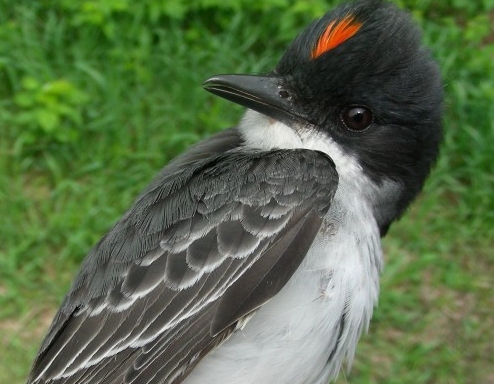
This after-hatch year female Eastern Kingbird is only the sixth ever to be banded at MBO. It just goes to show what thinking “Hey, wouldn’t it be nice to have a kingbird land in a net?” can do! (Photo by Marie-Anne Hudson)
| This week’s Top Ten [last week’s rank in brackets] | |
| # individuals banded | mean # individuals observed daily |
| Red-winged Blackbird (21) [1] | Red-winged Blackbird (57) [1] |
| Tennessee Warbler (12) [-] | Greater Scaup (25) [-] |
| American Goldfinch (11) [3] | Tree Swallow [2] |
| Nashville Warbler (8) [8] | American Crow [5] (22) |
| Yellow-rumped Warbler (6) [2] | American Goldfinch [4] |
| Yellow Warbler [6] (16) | |
| Yellow Warbler [4] Gray Catbird [-] (5) | Wood Duck (13) [-] |
| Ring-billed Gull (11) [3] | |
| Ruby-crowned Kinglet [5] | Canada Goose [9] |
| Gray Catbird [-] (5) | Black-capped Chickadee [-] |
| Warbling Vireo [-], | Song Sparrow [10] |
| Magnolia Warbler [8] | Common Grackle [7] (9) |
| Common Grackle [-] (4) |
Our top ten species observed is again somewhat different from last week’s, with a reduction in the number of Red-winged Blackbirds passing through MBO, though like last year they remain at the top of both lists. The addition of Greater Scaup is a little misleading, as they were present for only the briefest moment – their number simply overwhelmed everything else for the week. The abundance of Wood Duck, however, is completely accurate. Flocks were 10-15 birds are seen every day coming and going from the back pond. These flocks consist of both males and females, so we’re not quite sure what to make of this. Are these non-breeders, delayed-breeders or even failed breeders? We’ll be sure to keep our eyes peeled for ducklings in the near future, as one of our 3 resident pairs of Canada Geese are now parading around MBO with seven little ones.
Red-winged Blackbirds again dominated the top ten banded list, but overall the banding numbers were much lower than last week’s due to the reduction in banding hours. The warblers now occupy 6 of the top ten spots, with Tennessee taking a commanding lead. Their arrival was quite evident on Sunday morning when the dawn chorus (and much of the morning for that matter) was absolutely filled with tikka-tikka-tikka, tsibit-tsibit-tsibit, trrrrrrrrrrrrrrrrriiiiiii! This Tennessee wave wasn’t seen at all last year, highlighting how different each season can be, and the importance of continued monitoring. Though we banded 16 species of warbler, 2 “regulars” evaded our nets: Black-throated Blue and Black-throated Green Warblers. However, there’s still one week of banding left, so who knows – though for some reason both these species are much more common at MBO in fall (only 1 of 55 Black-throated Blue and 1 of 44 Black-throated Green Warblers banded at MBO have been caught in spring)!
This week was rather interesting in terms of returns (greater than three months between captures) and repeats (less than three months between captures). When extracting, it seemed as if every third bird was already banded! Granted it was more like one out of every five, but the number of returns was quite high, surpassing the number of repeats by a decent amount. These individuals, most of them banded in 2005, are likely returning to breed. Since the entire point of banding is to have as many recaptures as possible, we’re very excited about this flood of returns, and are eager to see what else is in store for us. Perhaps one day in the distant future, we’ll have a recovery as important as the one reported through the latest Bird Studies Canada newsletter: a 33-year old Northern Harrier was found, more than doubling the previous longevity record for the species. Though we don’t expect passerines to live anywhere near that long, we’re hoping to accumulate enough recapture data on our local breeders and winter migrants to establish some new records of our own!
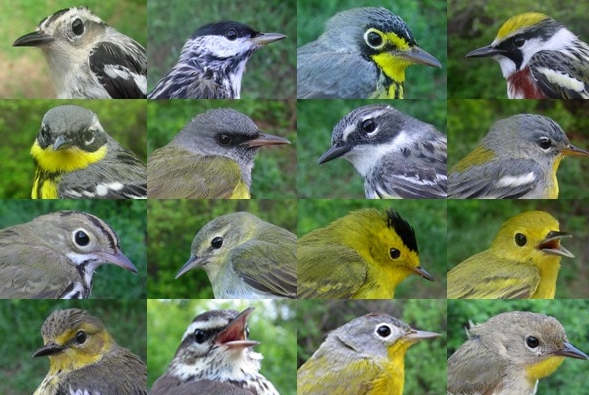
From left to right: FIRST ROW – SY-F Black-and-white Warbler, ASY-M Blackpoll Warbler, ASY-M Canada Warbler, SY-M Chestnut-sided Warbler SECOND ROW – ASY-F Magnolia Warbler, ASY-M Mourning Warbler, ASY-F Myrtle Warbler, ASY-F Northern Parula THIRD ROW – AHY-U Ovenbird, SY-M Tennessee Warbler, ASY-M Wilson’s Warbler, ASY-F Yellow Warbler FOURTH ROW – ASY-F Cape May Warbler, AHY-U Northern Waterthrush, ASY-M Nashville Warbler, and ASY-F Common Yellowthroat. (Photos by Marie-Anne Hudson)
Week 9: May 23-29, 2007
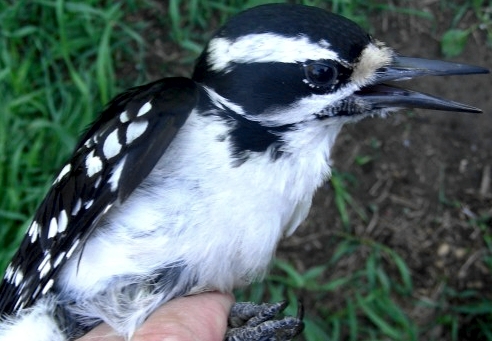
This third-year female Hairy Woodpecker represents a significant landmark for MBO, being
the 10000th bird banded since MBO’s inception in 2004. (Photo by Marie-Anne Hudson)-
| THIS WEEK | THIS SPRING | 2006 TOTAL | SITE TOTAL | |
| # birds (and species) banded | 169 (35) | 658 (57) | 699 (62) | 10017 (98) |
| # birds (and species) repeat | 32 (11) | 96 (17) | 108 (20) | 1657 (53) |
| # birds (and species) return | 14 (6) | 78 (19) | 82 (21) | 282 (28) |
| # species observed | 92 | 135 | 135 | 186 |
| # net hours | 533 | 2286.5 | 2323.5 | 16346.3 |
| # birds banded / 100 net hours | 31.7 | 27.8 | 29.9 | 61.2 |
Banders-in-charge: Marie-Anne Hudson, Barbara Frei
Assistants: Jean Beaudreault, David Bird, Leonardo Cabrera, Sophie Cauchon, Jean Demers, Rachel Gosselin, Gay Gruner, Amy Henderson, Helen Leroux, Barbara MacDuff, Betsy Macfarlane, André Pelletier, Jérôme Petigny, Clémence Soulard, Réal Ste-Marie, Rodger Titman, Rachel Verkade
Notes: It’s hard to believe that the 2007 Spring Season is almost over – it feels as if it just began! Migration has definitely slowed over this past week, likely due to a consistent westerly wind (varying between the occasional southwest wind, but usually a northwest wind) and the fact that we’re almost in June. Despite the slowing though, we experienced a very interesting week unlike any other to date: we were inundated by Blackpoll Warblers! Their high-pitched “tseeeep tseeeep tseeeep” calls emanated from pretty much everywhere, though they especially liked the hawthorns and buckthorns surrounding the A and E nets. If today’s birds were any indication (fat scores of 6 and 7 – you’ve never seen little butterballs like these guys!), they’ll likely leave on the first good tail wind, so enjoy them while you can!
Despite the apparent slowing of migration, our lowest DET was still 48 species, with a mean of 52 species for the week. This is a little lower than last year’s week 9, and is likely due to those westerly winds mentioned earlier (as opposed to southerly for a good part of the week last year). New arrivals include both Alder and Willow Flycatchers and Swainson’s Thrush. Six new species were banded: Swainson’s Thrush, Veery, American Redstart, Northern Rough-winged Swallow, Cedar Waxwing, and Red-eyed Vireo. There are still a few species missing from our totals that we had at this time last year: Indigo Buntings are proving to be quite elusive (observed but not banded), as are Gray-cheeked Thrushes and Philadelphia Vireos – they haven’t shown up at all yet! This didn’t seem to faze the Dean of Macdonald Campus, Chandra Madramootoo, who came out for a visit on Thursday. David Bird and Rodger Titman kindly served as enthusiastic hosts, guiding the Dean around the site and offering up historical tidbits. We certainly hope he enjoyed his visit, and extend him an open invitation to return!
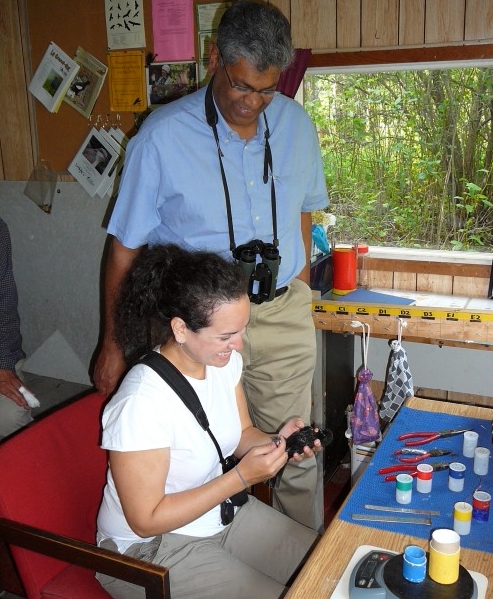
Dean Chandra Madramootoo making sure that Marie-Anne is accurately ageing
and sexing this young male Red-winged Blackbird. (Photo by David Bird)
| This week’s Top Ten [last week’s rank in brackets] | |
| # individuals banded | mean # individuals observed daily |
| Blackpoll Warbler (34) [-] | Red-winged Blackbird (49) [1] |
| Red-winged Blackbird (12) [1] | Tree Swallow (22) [3] |
| Cedar Waxwing (10) [-] | American Crow (21) [3] |
| Northern Waterthrush (9) [-] | Wood Duck (17) [5] |
| American Goldfinch [3] (8) | Yellow Warbler (15) [4] |
| Gray Catbird [6] (8) | Cliff Swallow (13) [-] |
| Batimore Oriole (7) [-] | American Goldfinch (12) [4] |
| Yellow Warbler (7) [6] | Canada Goose (11) [10] |
| Yellow-rumped Warbler (7) [5] | Common Grackle (9) [10] |
| Wilson’s Warbler (7) [-] | Baltimore Oriole (9) [-] |
| Blackpoll Warbler (9) [-] | |
| Cedar Waxwing (90 [-] |
Our top ten species observed list is quite different from last week’s, with several new additions: Baltimore Oriole, Cedar Waxwing, and of course, Blackpoll Warblers. However, the top spot again goes to the Red-winged Blackbird for the fourth week in a row. The rest of the list is rounded out by the ‘usual suspects’. Notable differences from last year are the relative scarcity of Ring-billed Gull and Mallard (ranked 1st and 4th for this week in 2006), and again the higher number of Tree Swallows compared to 2006, that we have now been noting for several weeks.
The top ten banded list was significantly upset this week with Red-winged Blackbirds falling to a distant second position behind the Blackpolls. The warblers occupied half of the top ten spots, with several little species-specific ‘pushes’ throughout the week: Northern Waterthrush on Friday and Wilson’s Warbler on Tuesday. A flock of Cedar Waxwings hanging around MBO also managed to find its way into our nets on a sporadic basis, pushing them to third position. A strong movement of Gray Catbirds and Baltimore Orioles mid-week brought in several new individuals. On the whole, six of this week’s top 10 were also on the list last year at this time, again showing a fair bit of consistency from year to year, though we know there will always be surprises each spring like this week’s Blackpoll invasion – and that’s what keeps things interesting! Going into our last week of spring banding, we wonder what the forecasted southwest winds and rain might bring in (hopefully the rain will come in overnight and not interfere with our operations!). We very much look forward to seeing you out at MBO for our last week, and thank you for your continued enthusiasm!
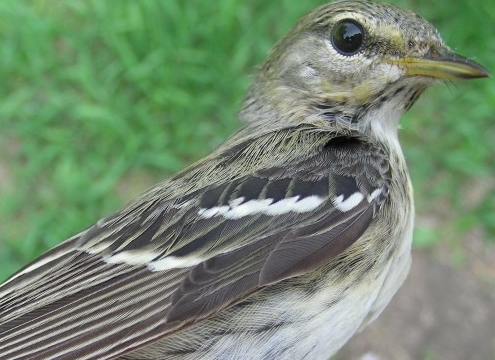
This second-year female Blackpoll Warbler was in good company as 33 of her traveling companions were banded and released this week. Blackpolls of all ages and sexes meant several quick photo sessions for our ever-growing online photo library.
(Photo by Marie-Anne Hudson)
Week 10: May 30 – June 5, 2006
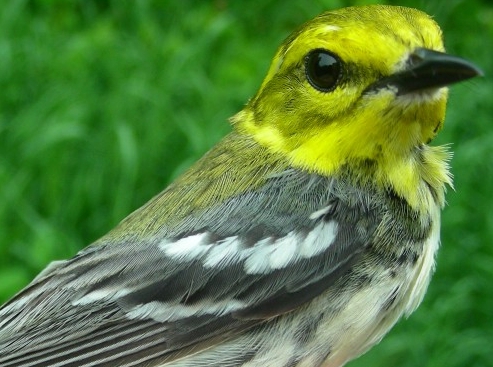
Apparently you get what you ask for at MBO! This after-second year female
Black-throated Green Warbler appeared in our nets on our final day of banding – two
days after we stated in the weekly report that we had yet to band this species! See
below for another species that was first banded on our last day. (Photo by Marie-Anne Hudson)
| THIS WEEK | THIS SPRING | 2006 TOTAL | SITE TOTAL | |
| # birds (and species) banded | 46 (17) | 704 (60) | 745 (65) | 10063 (98) |
| # birds (and species) repeat | 7 (5) | 103 (18) | 115 (21) | 1664 (53) |
| # birds (and species) return | 3 (1) | 81 (19) | 85 (21) | 285 (28) |
| # species observed | 80 | 135 | 135 | 186 |
| # net hours | 173.5 | 2460 | 2497 | 16519.8 |
| # birds banded / 100 net hours | 26.5 | 28.6 | 29.7 | 60.9 |
Banders-in-charge: Marie-Anne Hudson, Barbara Frei
Assistants: Jean Beaudreault, David Bird, Sophie Cauchon, Shawn Craik, Emily Gray, Gay Gruner, Barbara MacDuff, Betsy Mcfarlane, Heather Milligan, Marina Milligan, Chris Murphy, André Pelletier, Réal Ste-Marie, Rodger Titman
Notes: MBO’s 2007 spring season, its third, has now come to a close. Migration seemed to come to a screeching halt the day after our last day of banding – enabling us to let out a big sigh of relief that we hadn’t missed too many late migrants. The week consisted of 3 days of full operation followed by 4 days of census only, the results of which reflected largely a breeding bird community, and not a migrating one. While there were no new species observed this week (just like last year), 3 new species were banded for this spring: Yellow-shafted Flicker, Indigo Bunting and Black-throated Green Warbler, bringing our total number of species banded during the season to an even 60. That leaves us just 3 species shy of last year’s total at this time.
On Thursday we were lucky to receive our second senior McGill visitor for the season, the chair of the Natural Resource Sciences Department of Macdonald Campus, Benoît Côté. He was given a tour of MBO, much like Dean Madramootoo, and was shown the basics of banding. We certainly hope he enjoyed his visit and wish him many happy returns to MBO.
| This week’s Top Ten [last week’s rank in brackets] | |
| # individuals banded | mean # individuals observed daily |
| Blackpoll Warbler (10) [1] | Red-winged Blackbird (35) [1] |
| Cedar Waxwing (7) [3] | American Crow (20) [3] |
| Red-winged Blackbird (6) [2] | Tree Swallow (16) [2] |
| American Goldfinch [4], Common Yellowthroat [-] and Magnolia Warbler [-] (3) | American Goldfinch (10) [7] |
| Cedar Waxwing (9) [10] | |
| Northern Waterthrush [4] and Traill’s Flycatcher [-] (2) | Yellow Warbler (9) [5] |
| Common Yellowthroat (6) [-] | |
| 10 species tied with 1 individual each | Song Sparrow (6) [-] |
| Cliff Swallow (6) [6] | |
| Wood Duck (5) [4] |
Our top ten species observed list is fairly similar to last week’s, reflecting the slowing of migration (and hence reduced species turnover). New additions include an influx of Common Yellowthroats at the start of the week, and the re-appearance of the Song Sparrow. However, the top spot again goes to the Red-winged Blackbird for the fifth week in a row. Notable differences from last year are the scarcity of Canada Goose, Ring-billed Gull and Mallard (ranked 2nd, 4th and 9th for this week in 2006). This may have to do with the fact that the fields next to MBO were planted this year and are quite long and green at the moment. The Bobolinks continue to burble on territory over these fields this year, indicating that they are now much more suitable habitat for grassland birds than for gulls and waterfowl.
The top ten banded list was again upset this week with Red-winged Blackbirds falling to third position behind the Blackpoll Warblers and Cedar Waxwings. The warblers used the nice tail winds early in the week to continue their journey northward, causing them to decrease in number substantially. However, 4 still occupied the top spots (not counting the species tied for 10th spot with 1 individual banded). Only the top 3 of this week’s top 10 were also on the list last year at this time, showing how different each year can be.
We finished off this spring with 135 species observed; 13 less than last year. This is likely due to differences in observers on site, but could also be a true reflection of a decrease in species abundance on-site. More detailed summaries and analyses of the spring data will be presented in the full seasonal report, due out within the next month. Watch for our monthly summer updates at the end of June and July; weekly updates will resume with the start of the Fall Migration Monitoring Program in August.
| SPRING SEASON TOP TEN BANDED | ||
| # individuals banded 2007 | # individuals banded 2006 | # individuals banded 2005 |
| Red-winged Blackbird (154) [1] | Red-winged Blackbird (168) [1] | American Goldfinch (111) [3] |
| Ruby-crowned Kinglet (55) [2] | Common Grackle (59) [-] | Red-winged Blackbird (74) [1] |
| American Goldfinch (51) [3] | Ruby-crowned Kinglet (55) [-] | Cedar Waxwing (59) [-] |
| Blackpoll Warbler (47) [4] | Slate-coloured Junco (47) [4] | Yellow Warbler (47) [4] |
| Yellow-rumped Warbler (32) [-] | White-throated Sparrow (42) [9] | Song Sparrow (30) [2] |
| Yellow Warbler (29) [-] | American Goldfinch (32) [3] | White-throated Sparrow (29) [5] |
| Baltimore Oriole (18) [-] | Common Yellowthroat (25) [-] | Yellow-rumped Warbler (25) [6] |
| Common Grackle (18) [-] | Yellow-rumped Warbler (22) [-] | Common Yellowthroat (22) [-] |
| Cedar Waxwing (17) [-] | Magnolia Warbler (22) [6] | Ruby-crowned Kinglet (20) [8] |
| Magnolia Warbler (17) [6] | Yellow Warbler (21) [-] | Common Grackle (20) [10] |
The table above provides a brief preliminary summary and comparison with previous spring migration monitoring seasons at MBO. It reflects both the consistency and inter-year variability that we have noticed throughout the season. Six of the species (Red-winged Blackbird, Ruby-crowned Kinglet, American Goldfinch, Yellow-rumped Warbler, Yellow Warbler, and Common Grackle) have been among the ten most frequently banded birds each of the three years. Even these species vary considerably in abundance from year to year – for example, the number of Common Grackles banded dropped by over two-thirds from 2006, and while Red-winged Blackbirds were similar in number this year and last, they were far less common in 2005.
The most notable changes this year, however, were the surprise abundance of Blackpoll Warblers late in the season, catapulting them to fourth place for the season, and the complete absence of Slate-coloured Juncos from the nets in sharp contrast to their fourth place status in 2006. Their drop-off can be partly explained by the banding season starting two weeks later this year, but even so it is a dramatic change. Similarly, the White-throated Sparrows that were consistently common in the first two years fell out of the top ten this spring, with only 13 banded. More analysis of these and other patterns will be explored in the full spring report.
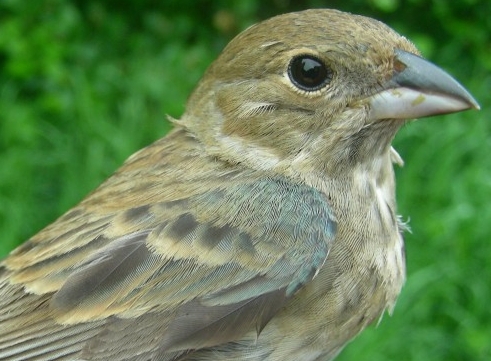
This after-second-year female Indigo Bunting also became the first of her species to be banded this spring. It’s no surprise that these late-comers were older females, as many passerines exhibit differential migration: young males head north earlier than the older males, which are followed by the young females, and the older females are the last to arrive. This is mostly due to the fact that the young males must seek out the best territories before the older males arrive if they hope to breed. Conversely, the older females can take their time, so to speak, allowing the males to duke it out before the females make the long trek northward.
(Photo by Marie-Anne Hudson)
